Editor’s Note: This story contains descriptions of animal abuse and trauma related to a rescue dog.
Introduction: Tripod’s Story
Can anyone own a 4-legged canine rescue? Three-legged? Toothless? Hacked off tail? Tongue hanging? Old? Damaged?
I’ve never owned an old rescue dog before; opting for pedigreed puppies. Slated for euthanasia, prospects for her “forever home” were grim. She was old, crippled, had her tail reduced to a stump, and over-bred. She spent most of her life confined to a crate. She was even set on fire to “cure” scabies and never benefited from veterinary attention. She was a 9-pound, scrap of a mutt, with two front legs and one in the back. Wormy, starved and limping.
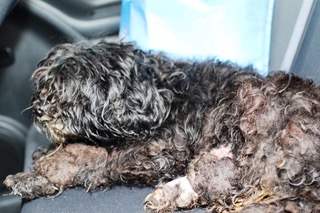
She was discovered on a Houston freeway by Red Collar Rescue, eating garbage, blinded by overgrown hair, with dull eyes, limping, diseased ears, and rotten teeth; barely alive. She was rushed to their rescue veterinarian.
She had three bullet wounds that shattered her back leg bones, leading to her hind leg being amputated at the hip. A bullet was removed from her front knee. She had heartworms, parasites, and a hole in her gums. While anesthetized, she also had her rotten teeth pulled and was spayed. Later, she was dewormed, bathed, vaccinated; ears medicated and shaved.
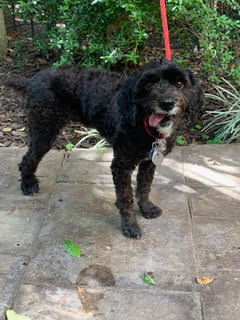
She had to recover at her Red Collar foster home, which provided food, medications, wound care, and limited her mobility. I offered to adopt this dog and have her in my home – I submitted all the paperwork and waited.
“Ok,” I thought when the Red Collar agreed, their folks dropped her off after a brief recovery, and she staggered shyly into a corner. “I can do this.”
I took her for medical care: an anti-parasite regimen, blood tests, bathing, grooming, and of course, a healthy dog diet. I renamed her Tripod. She was a noun, verb, and biological mess. But, she loved to eat and squeaked when I prepared her meals.
Due to total tooth extraction, her tongue hung out, and she drooled. She limped and had large tumors along her spine. Sutures from amputation and jaw surgery were tender; she was skinny, ugly, shy, twisted, and slurped her food. I gave her a little bed with clean blankets by a patio door and hoped for the best. She spent hours asleep – waking only to potty or eat.
I bought her a little Henley shirt for warmth and used her Red Collar leash and collar when walking. After several months, she blossomed into a sleek, bright, loyal companion. Her stump of a tail wagged, and she relaxed. She put on a few pounds, and her tumors shrank. Her eyes brightened; fur glossy, balanced well on three legs, and looked good.
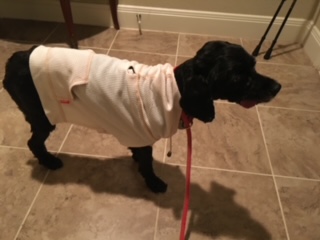
Recently retired and widowed, with both sons married and gone, I had the time to dedicate to a damaged dog. I also loved to hike, camp, cycle, and kayak – to get dirty, and always a sucker for down-and-out animals. Few women did those things. Even fewer who were my age, and they rarely did these activities solo.
I was rehabilitating Tripod when the Covid-19 pandemic hit, limiting our ability to participate in society. I’m an aged 71 retired science teacher who has been camping, biking, and hiking all her life. Luckily, I had great teachers in outdoor and survival skills and grew up climbing, hiking, and ranching. I knew the joy, heartbreak, rigor of expeditions, and importance of careful planning. I could hike, read a compass, maps, and endure discomfort.
Planning and Preparing for the Trek with Tripod
During winter, I researched a state “long trail,” got the topographic map, planned my route, and trained on a StairMaster. I spent the next several months training, “climbing” on a Stair Master with a progressively heavy pack, and buying the latest and greatest lightweight gear. I also tested out my tent and calculated the R-values of my sleeping pad and quilt. Over the years, I have slowly obtained high-quality hiking gear. The lighter the gear weighs, the more it seems to cost.
I decided on the Colorado Trail (CT) as most National Trails were closed due to Covid. It was also an area I was intimate with – I grew up in Denver, worked in Evergreen (which was then a small village in the “foothills” of Denver), and had a summer place in Bayfield – a small town near Durango, CO.
The Colorado Trail was convenient for a summer thru-hike. It was popular, and I had the time to hike the entire 560-odd miles, starting from Durango on the west side and ending near Denver on the east.
At my tender age, I really did not have any years to wait for things to return to “normal.” Now was as good a time as any. Much within society was shut down, people were laid off and lost their jobs. Quarantines, “closed” signs, and face masks were everywhere. But with many State and National parks closed, the Colorado Trail was still open.
The Colorado Trail is 567 miles routed over the Continental Divide. Construction began in 1974 and was “finished” in 1989, connecting Durango, CO, a small town west of the Continental Divide, and runs to Littleton, CO, another town near Denver, east of the Continental Divide and runs through the Rocky Mountains of Colorado.
The Colorado Trail passes through 8 mountain ranges and 6 wilderness areas while averaging 10,300 feet (3,140 m) in elevation. It is high, wild, and dangerous. I had been on it before, 40 years ago with younger knees and better eyes. I didn’t know if Tripod could finish the trail, let alone if I now could! I consoled myself with the idea that if the Colorado Trail was too hard, I could descend to a nearby mountain town and hop onto a bus. Besides, I was bullet-proof, right?
Not wanting to board the dog for an extended period, Tripod, now healthy, would join me. I began the complicated business of trail logistics for herself and me – clothing, poles, packs, shelter, food, water, cookware, clothing, raingear, dog-gear, navigation, medications, vaccinations, and the financial means to make it.
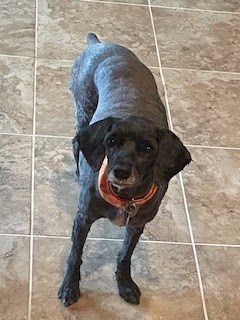
We needed endurance, careful planning, compliance with forest and wilderness regulations, knowledge of how to cope with local animals, and physical, mental, and emotional strength. During our training, I evaluated Tripod’s trail worthiness, health, and ability.
Having only three good legs and her body size were concerns. She was willing, but making her carry any weight seemed cruel. It had me thinking about doing simpler day trips with her – out-and-back hikes if she proved unfit or unwilling.
I took her to my veterinarian, also an animal rescue owner, and he supported my goal of hiking 567 wild miles with this dog on the Colorado Trail. His usually grumpy attitude evaporated, smiled, and became upbeat. He thought it a terrific idea and bent over to scratch her ears. He carefully examined her; checked her vitals, took x-rays, updated her vaccinations, and advised me on Tripod’s caloric needs. He also cautioned that not all dogs liked hiking and told me to watch her attitude carefully.
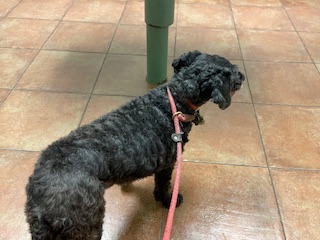
Among other things, he said to not let her run free, or drink any unfiltered water source. He provided a few medical items for emergencies and announced, to my utter amazement, she was physically fit enough for the trek. Then he left, grumpily trying to explain the Colorado Trail to his bewildered vet techs.
A few days later, I went to my doctor, sharing with her my plan, asking for antibiotics, antifungal medications, and antiviral medications as well as medicated creams and altitude medications. I also had blood tests and lower back X-rays. She kindly provided the prescriptions, and her entire office wished us well. I had good test results, and we were both approved for our hike.
I was anxious; it all seemed too easy. I still had to carry 35 pounds, stay highly organized, and endure a long trail. I shrugged. Tripod was lifted into my high clearance, four-wheel drive Subaru, rigged with an orthopedic canine bed, and she immediately settled into sleep.
We spent the night in a dog-friendly but run-down, dump of a hotel, about halfway on our journey where I fed and walked Tripod. The hotel housed fierce-looking Hispanic male utility workers, cooking their meals on smokey, charcoal stoves outside their rooms. They looked up and politely grinned at Tripod and me then waved us over. All perceived fierceness gone. Their smiles twinkled from stainless steel implants while they petted Tripod, politely called me Professora, and offered a place to sit. Then, the cook pushed a plate into my hand, loaded with steamy barbecue, rice, pinto beans, and fluffy tortillas; they handed me a huge cup of iced sweet tea, then sat back, politely waiting for me to begin the meal while they petted Tripod.
I used my limited junior-high level Spanish to converse, and between them not speaking English and my poor grammar, we had a great time. Tripod nuzzled her hosts, received many pets, and then wandered over to me, quietly laid down, arranged her tongue, sighed, and slept.
In the morning, as I walked the dog, they smilingly offered foil-wrapped, scrambled egg tortillas with salsa and freshly brewed coffee. Each helped load gear, shook my hand, and wished us a safe journey; then climbed into their utility trucks. Each man wearing a yellow safety helmet, orange vest, and assumed fierce looks.
Later, filling the car with gas and checking oil and tire pressures, I thought about prejudice, gratefully considering the kind men we met, and wished them well. Tripod and I were headed to Durango, Colorado.
I made arrangements for my car to be safely garaged not too far from the Trail. Although pricey to store, the CT disallowed parked vehicles. On our way to the CT, I rationalized it was better for a dog to be pampered on a Trail than confined to a crate, neglected, then abandoned.
Food and Gear
Keeping us well-fed on the Trail was a daily challenge. I carried dehydrated dog food and vitamins, portioned into sealed baggies, mixing with clean water to make a calorie-rich gruel twice a day for Tripod. I picked up her waste with special Leave No Trace (LNT) bags and carefully sanitized our water and food. I protected her three good paws with booties worn by Alaskan sled dogs and walked her using an UL dog leash. If it was chilly or rainy, she wore a fleecy, hooded waterproof dog jacket. I consumed miserable dehydrated food, wore thrift store clothes, and trash bags as “rain gear”.
However, I invested in everything else – it was a necessity after previously fracturing my back – carried an ultralight tent, carbon fiber poles, ultralight cookware, an umbrella, an insulated sleep pad, a quilt, and a robust water sanitation unit. Giardia, a microscopic intestinal parasite affecting humans, and only treated by a medical doctor, took me off a long Trail a few years ago. Having learned the painful lesson, food and water preparation became a scrupulous, almost religious endeavor.
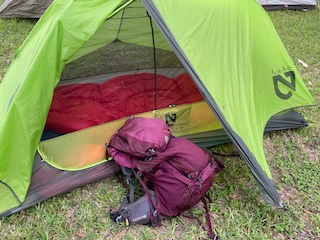
Tripod wore tiny panniers with a little battery-powered light. I worried any extra weight may stress her “good” back leg and deliberately kept her pack light. Her pack pockets were balanced with empty potty bags, her doggy raincoat, an extra leash, a red dog sweater her groomer gave her, bandages, snake bite antivenom, medicated paw cream, extra booties, and batteries for her light. I carried everything else.
I had a 70-liter Gregory “Diva” XS pack; internal frame, load lifters, torso length adjustment, “brain” zippers, waist belts with pockets, and a shoulder pocket. I also wore a Hyperlite Mountain Gear fanny pack and carried a high lumen headlamp on my head for doing camp activities and hiking in the dark. Altogether the pack was 35 lbs, which was good – I could not carry anything heavier.
Grinding her commercial dog chow fine in a Vitamix was the basis for Tripod’s meals. For each meal, I added 1/4 teaspoon each of calcium, probiotics, and salmon oil, as well as about 1/2 teaspoon raw turkey before dehydrating everything and portioning her meals into sealed dehydration bags. I would feed her about 1/2 cup twice a day, rehydrating her food with boiled water mixed with cool water.
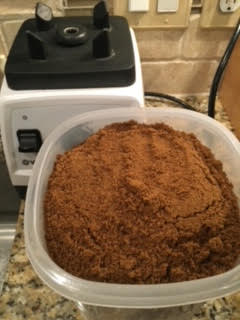
Tripod and I would sleep in my one-person tent on or in my quilt. I used a tent stake tied to her leash to keep her close while pitching my tent and fly. As we hiked the dog looked glossy, fat, gaining weight while I lost. I kept her leashed and walked at her pace.
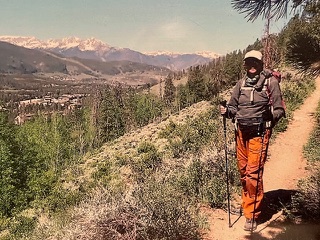
Along the Trail
About two weeks into our hike, we met two retired elementary school teachers sitting at an empty campground picnic table taking a break. Both were from Minnesota, and both were named Kathy. One Kathy had her small dog, and the other Kathy owned a larger breed. As we had the campground to ourselves we allowed our dogs to play. All the dogs relaxed, sniffed tails, and ran. One Kathy fostered dogs in her home; tending dogs recovering from emergency surgeries. I admired her, sharing Tripod’s story. One of the Kathy’s small mutts wore a doggie pack. Seeing it, I made a note of the vendor in the hope to obtain one similar.
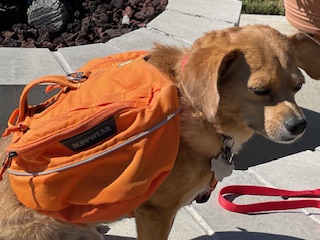
We visited, comparing gear, dogs, and remedies for ailments before exchanging contact information. It was still light, and they wanted to hike further that day, so the two Kathys packed up and continued their trek, dogs in tow. The larger dog with packs bulging; the smaller dog, tail wagging madly.
Glancing at my map, Lake City was not too far away. However, I had to locate a dog-friendly store, as I needed to restock food. Tripod and I descended into Lake City near Highway 149, then hitched a ride in a beat-up Toyota minivan occupied by three young men on their way to one of Colorado’s small colleges. Tripod sat in my lap. They dropped us off on a side street and wished us well.
I hefted my pack onto my shoulders, lifted the dog down, arranged my poles, and got the dog’s leash around my wrist. I was worried about Tripod and I being so grimy as we walked down Lake City’s main street. It was about noon, but everything seemed vacant. The town was about three streets with each building boasting clapboard siding.
Trying to look as nice as possible and removing my sunglasses, I asked for the manager. A tatted, multi-pierced, blue dreadlocked spectacle of a young woman politely asked how she may help us. I said we were hiking the CT, her store was mentioned as a resupply spot, and may I please bring my companion dog into her shop.
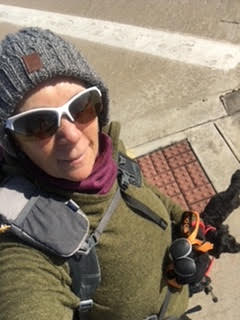
“Of course, you may! You remind me of my Grandmother! I’d do anything for her. How may I help!” That comment about her Grandmother stung. After all, I was a real grandmother to my older son’s two children, but I was still feeling smarted. However, she allowed Tripod inside.
I asked if there were dog-friendly hostels close by. I anxiously noted that the sun was dropping behind the mountains, one of Colorado’s monsoons was brewing, and it was getting cold. Getting a shelter and hot meal seemed great, but I was also worried about the dog. One of the store clerks had a spare room and was getting off soon. She would be happy to help us. As I had learned before on this trek, I again felt guilty for judging these nice people by their appearances.
Tripod, always a celebrity, had people bent over stroking her fur. Her tongue hung wildly out, and her stumpy tail wagged.
“Great,” I thought wryly. “Now I’m a groupie to a mutt.” Our sales clerk completed our transaction and gave Tripod a small commercial dog treat. I mentioned she had no teeth and would probably choke pulling it from her maw. He profusely apologized and came from his register in tears to pet the dog.
We spent the night at the clerk’s house. Her name, we found out, was Jean, from Cincinnati. Jean provided clean sheets, new soap, shampoo, and her hair dryer. Her spotless bathroom was shared between my room and hers. Was this a gift from the Universe?
Her hot shower was divine. I reapplied some LeukoTape to my feet while Tripod slept on the bath mat. Later, taking Tripod for her night potty, I stared at the clear stars, and although not religious, thanked The Creator for incredible nights and loving people.
In the morning, we shared a great meal with real, non-instant coffee. Her family was curious about us – where we lived, our ages, and if I had guns. I offered to pay for our lodging and meal, but they refused, sharing: “God was with in.” They nodded at Tripod, hugged their Down Syndrome family member. I insisted we stop for a photo.
Then, they took us to the Trail. Seemingly unaffected by altitude, solitude, rain, and close lightning, Tripod pranced easily up root-filled trails, across alpine meadows, and down snowy slopes. She kept her bright eyes on me, ears cocked, and nose up. We frequently marveled and smelled wildflowers. Tripod gleefully rolled in exotic animal droppings, slept in my tent, ate well, and hissed away “bad guys” at night. She did not comment on my unbathed odor, ignored iffy weather, weaved around my hiking poles, and waited patiently, as I parsed map and compass.
I carried everything for us both in my heavy and awkward backpack, while wearing a fanny pack, chest pack, compass, and whistle on strings around my neck, topo map and reading glasses in my fanny pack.
“Gosh,” I grumbled, shifting my pack weight off sore shoulders. I leaned heavily on my poles and said out loud while trying to ignore a throbbing altitude headache and vague nausea: “Tripod has three legs, and I could barely make it with two ‘good’ ones.”

She hiked it all to my astonishment, never unwilling, tired, or lame. I could not say the same. Heel blisters ruptured. Gums bled. Knees sore. Toenails died.
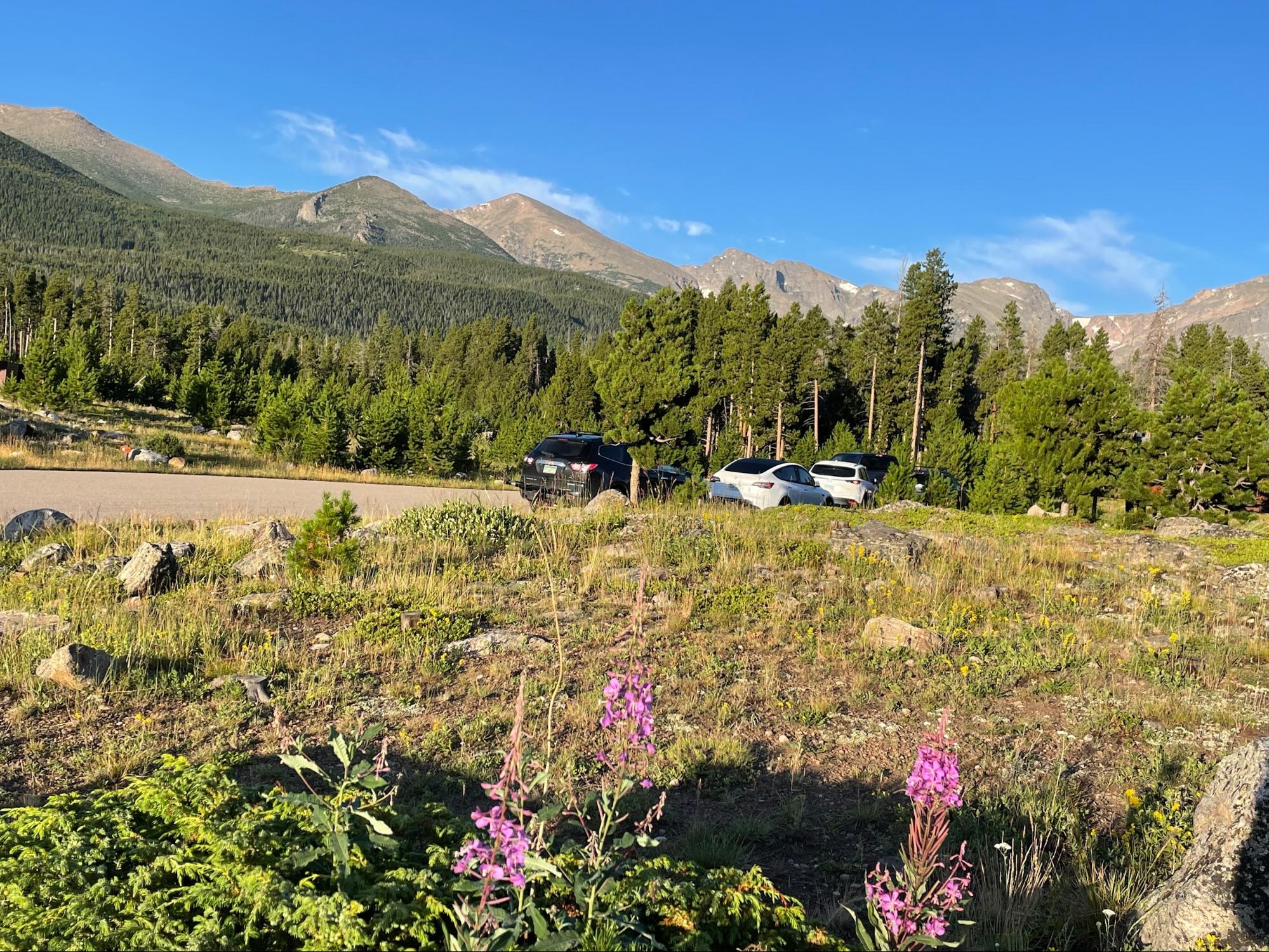
I hurt everywhere and wanted to quit a thousand times. This “damaged” dog was my best trail companion – ever. She was cheerful, non-judgmental, and never complained. She was always in the moment, wanting only me. Her oversight encouraged completion by distracting me from my aching body.
At the trail’s end, we took a west-bound bus back to Durango. We were both odious, which aided our separation from the more clean-conscious riders who left us alone. Lifting her onto the empty seat by me, I reflected: A “damaged” rescued, old mutt just walked 567 miles on 3 legs, and we met wonderful people. She transcended obstacles, overcame limitations, and time vanished. We were both whole and drifted into sleep.




Home › Forums › Hiking with Tripod on the Colorado Trail